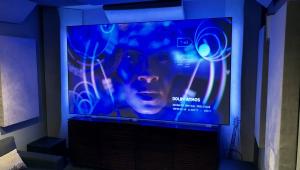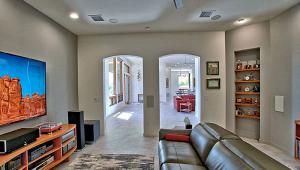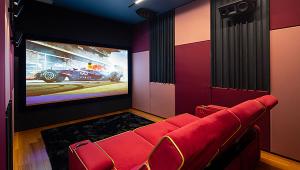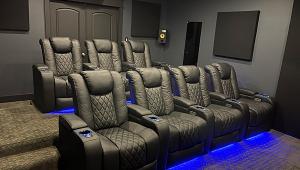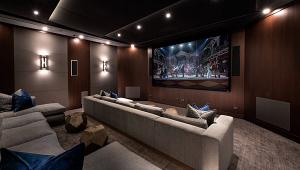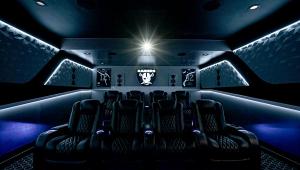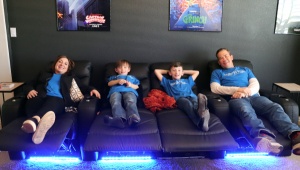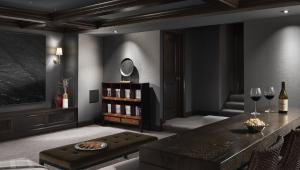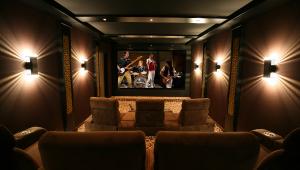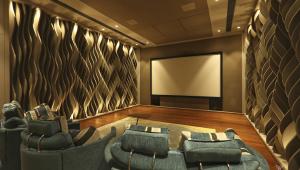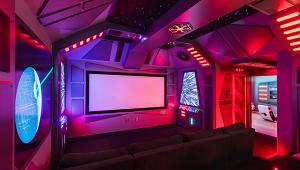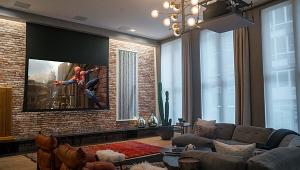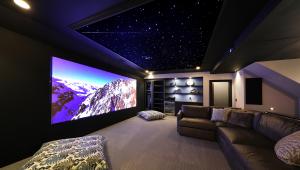Only the initial picture of the room shows up. The others have only the box frame and an x marked box. The picures did not load coreectly.
Mile-High DIY

Like most readers, I always dreamed of having my own dedicated space for a home theater. Unfortunately, while living in Southern California, we never had enough space. Then came a job opportunity in the beautiful state of Colorado, and our new home had a basement that was the perfect size and location for a home theater. I have a demanding job in the aerospace industry, so my available time to work on the theater was extremely limited. The process of design, prep, construction, and finishing took about two and a half years to complete. Outside of blowing insulation into the walls and ceiling and installing the carpet, I did all the work myself.

In determining the design and layout, I decided to keep the movie theater itself very simple; no distracting pictures or knick-knacks. It’s just a theater. The room dimensions were 13 feet wide, 22 feet long, and 7.5 feet high. The low ceiling and several drop-down air ducts made stadium seating a challenge. I compromised by limiting the rise of the two platforms to 6 inches each, which still allowed for good viewing in all rows.

To isolate the theater from outside noise such as the forced-air heating/AC unit and from the kitchen above, I used sound-deadening panels and blown-in cellulose insulation. Using an online resource, I calculated the amount of acoustic dampening needed to quiet the room without making it dead. I installed five black, 4-inch-thick, Rockwool acoustic panels in the room’s corners and ceiling, and seven 2-inch-thick panels around its walls. This created the simple look and basic theater aesthetics I wanted. The room was finished with deep oak, crown and base moldings, and a dark-chocolate painted ceiling.

The components cabinet was designed to maximize ventilation with fabric panels in the cabinet’s top to help dissipate heat and special shelving that allows good airflow. I cut a large opening in the wall (with a removable/sealed wall panel) behind the cabinet for easy access to the gear. I also installed internal lighting to help with the numerous connections.

For speakers, I used GoldenEar TritonCinema Twos, except for a pair of Definitive Technology ProMonitor 800s for the back surrounds. In addition, two Hsu VTF-2 MK3 12-inch powered subwoofers were used, one in the front and one in the back of the room. An Onkyo TX-SR806 powers the speaker system and accommodates several sources, including an Oppo BDP-93 Blu-Ray player, three game consoles (PS3, PS2, and Wii), and even a Denon DP-30L turntable. On the video side, a Sony VLP-VW85 projector was paired with a Stewart StudioTek 130 G3, 100-inch diagonal screen.

Finally, I chose the Logitech Harmony 900 remote due to its RF capability and ease of use. The RF blaster was mounted on the ceiling to effectively reach the gear. The remote also controls the lighting, which includes four front ceiling can lights, six rear ceiling can lights, and the window well scene lighting. The final lighting touch was the addition of floor/step lights for that real-theater feel.

Despite the length of time it took to complete this project, it was a real labor of love. However, Mother Nature decided to provide the greatest challenge of all that almost ended my dream of a dedicated theater. While I was putting on the finishing touches, calamity struck. Denver had a cold snap with temperatures dipping below -20 degrees Fahrenheit. One of the pipes in the theater’s ceiling froze, splitting a copper elbow, which collapsed the ceiling and created a deluge over my years of work. I still vividly remember the pit in my stomach as I sloshed around the basement assessing the damage. So what to do? Dry off and start the process over again. After months of rebuilding, I now have my man cave back in full operation.
- Log in or register to post comments


Gorgeous, clean and simple. I actually do like the visible speakers and wouldn't change the setup at all.

A dedicated room isn't it's all cracked up to be. After spending much time and money converting an unused dedicated sound room into a great home theater room we found it was just to disconnected from things and usually spent most time watching TV and listening to music in the centrally located living room.

You wrote "Using an online resource, I calculated the amount of acoustic dampening needed to quiet the room without making it dead"
Can you give me the link so I can start to understand the difference.
BTW this is a very nice room I have the exact same space available in my basement.

